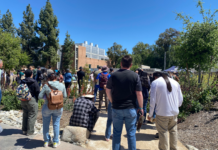 The latest buzz in the scientific community has been around the recent rediscovery of an elusive species of bumblebee that was last seen in the United States in 1956. On Monday, Dec. 5, 2011, a team of UC Riverside scientists announced that the species, known as “Cockerell’s Bumblebee,” was found living in the White Mountains of New Mexico.
The latest buzz in the scientific community has been around the recent rediscovery of an elusive species of bumblebee that was last seen in the United States in 1956. On Monday, Dec. 5, 2011, a team of UC Riverside scientists announced that the species, known as “Cockerell’s Bumblebee,” was found living in the White Mountains of New Mexico.
After more than a half-century of disappearance, the bees were located during a summer expedition carried out by UC Riverside scientists Douglas Yanega, Keve Ribardo and Greg Ballmer. Three specimens were collected for research along a highway north of the New Mexico town of Cloudcroft on Aug. 31, 2011. Cockerell’s Bumblebee is unique in that its biological characteristics have yet to be studied and its distribution has the most limited range of any bumblebee species in the world, occupying a small area of less than 300 square miles.
In an interview with the Highlander, Yanega said, “With the resurfacing of Cockerell’s Bumblebee, people are now alerted to its existence, which is certainly a lot better than people not even knowing or believing it’s a real organism, sort of the reverse of the situation with the endangered Florida panther, which has recently been declared to not be a distinct entity.” After testing the DNA of the collected specimens, the scientists confirmed that there is enough decisive evidence to verify Cockerell’s Bumblebee as a genuine and original species.
The scientists are assessing the genetic makeup of Cockerell’s Bumblebee in relation to similar species in hopes of determining its closest living relative. As for additional work with Cockerell’s Bumblebee, Yanega said that nothing further was planned. “The first step is to come to a firm conclusion regarding the status of this bee as a species. The second step is spreading the word to the scientific community that this bee deserves some attention, as it has been completely overlooked. Here at UCR we may or may not be involved beyond that point, in gathering data on the distribution and biology of this species, but at the very least our discovery can get the proverbial ball rolling,” explained the scientist in the newsroom article.
Yanega stated that the expedition was funded in part by the Friends of the Entomology Research Museum, a supporting non-profit organization. “Almost every field trip we take we either discover something new or rediscover something rare. That’s sort of the whole point to being an entomologist in the first place, since it certainly isn’t about glamour, money, or prestige,” concluded Yanega.








